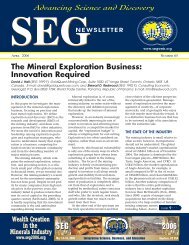Stewart R. Wallace — 1919–2009 - Society of Economic Geologists
Stewart R. Wallace — 1919–2009 - Society of Economic Geologists
Stewart R. Wallace — 1919–2009 - Society of Economic Geologists
Create successful ePaper yourself
Turn your PDF publications into a flip-book with our unique Google optimized e-Paper software.
JULY 2009 No 78 SEG NEWSLETTER 25<br />
<strong>Society</strong> <strong>of</strong> <strong>Economic</strong> <strong>Geologists</strong><br />
U2009 Field Course –<br />
Uranium Deposits <strong>of</strong> the Colorado Plateau<br />
May 6–10, 2009<br />
In conjunction with the U2009 conference<br />
in Keystone, Colorado, the <strong>Society</strong><br />
<strong>of</strong> <strong>Economic</strong> <strong>Geologists</strong> organized a<br />
four-day field course dealing with sandstone-hosted<br />
uranium deposits <strong>of</strong> the<br />
southwestern Colorado Plateau region.<br />
Seventeen participants represented uranium<br />
mining and exploration companies,<br />
and many <strong>of</strong> them brought experiences<br />
from various uranium districts<br />
around the world.<br />
The course began in the Laguna-<br />
Jackpile mine area west <strong>of</strong> Albuquerque,<br />
New Mexico, where an initial review <strong>of</strong><br />
Mesozoic stratigraphy described uranium<br />
occurrences in the Jurassic age<br />
Jackpile Sandstone, which make up the<br />
stratigraphically highest uranium<br />
deposits <strong>of</strong> importance in this part <strong>of</strong><br />
the Colorado Plateau. This was followed<br />
the next day by a review <strong>of</strong> deposits in<br />
the prolific Ambrosia Lake area, where<br />
Joe Lister <strong>of</strong> Rio Grande Resources provided<br />
historical, geologic, and production<br />
background information <strong>of</strong> the<br />
high-grade but currently inactive<br />
Mount Taylor mine; outcrops <strong>of</strong> the<br />
major Jurassic age host rocks were also<br />
examined, with emphasis on the<br />
Morrison Formation and its members in<br />
the Grants region. Geologist Josh Crook<br />
William X. Chávez, Jr. (SEG 1990 F), and Erich U. Petersen (SEG 1986 F)<br />
Uranium field trip participants pose for a group photo.<br />
<strong>of</strong> Neutron Energy Inc. provided details<br />
on the historical production in<br />
Ambrosia Lake.<br />
Traveling to the famous Big Indian-<br />
Lisbon Valley area <strong>of</strong> southeastern<br />
Utah, our group was treated to an<br />
underground visit<strong>—</strong>and lunch<strong>—</strong>at<br />
Denison Mines Pandora mine near La<br />
Sal. Jim Fisher <strong>of</strong> Denison Mines organized<br />
this part <strong>of</strong> our course, and made<br />
sure that our visit to the La Sal area was<br />
productive and enjoyable. The visit<br />
allowed participants to observe the<br />
nature <strong>of</strong> stream channel systems and<br />
the significance <strong>of</strong> organic matter as a<br />
reductant in these sandstone-hosted<br />
deposits. Besides getting a first-hand<br />
look at exposures <strong>of</strong> the Salt Wash<br />
Member <strong>of</strong> the Morrison Formation, we<br />
also discussed the geochemistry <strong>of</strong> uranium<br />
and vanadium, and the variability<br />
<strong>of</strong> V/U ratios in these ore deposits <strong>of</strong><br />
the Colorado Plateau. A follow-up visit<br />
to the historic Big Buck mine along<br />
Steen Road<strong>—</strong>named after Charles Steen,<br />
an unlikely pioneer in uranium exploration<br />
and discovery in the Moab<br />
area<strong>—</strong>gave participants the chance to<br />
observe the stark contrasts between oxidized<br />
and reduced zones within the<br />
Triassic age Chinle Formation.<br />
Anthony (Tony) Adkins, <strong>of</strong> Nucla,<br />
Colorado, provided an excellent series<br />
<strong>of</strong> mine and former mine stops the following<br />
day, as we visited the Lisbon<br />
mine <strong>of</strong> Constellation Copper Corpora -<br />
tion, followed by stops at key outcrops<br />
and former mine sites in the Utah-<br />
Colorado border region east and southeast<br />
<strong>of</strong> Lisbon Valley, ending at the<br />
Burro mine near Slickrock, Colorado.<br />
The mine visits <strong>of</strong>fered the chance to<br />
not only see the various styles <strong>of</strong> copper<br />
and uranium mineralization in sandstones<br />
<strong>of</strong> Cretaceous (Lisbon mine) and<br />
Jurassic ages, but the opportunity to<br />
discuss the complex geochemistry <strong>of</strong><br />
uranium and vanadium in terms <strong>of</strong><br />
transport, precipitation, and redox<br />
considerations.<br />
Our final day was spent traveling<br />
from eastern Utah to Keystone, with<br />
stops at outcrops and overlooks characterizing<br />
the Jurassic stratigraphic section<br />
<strong>of</strong> western Colorado; David Levy <strong>of</strong> Tetra<br />
Tech provided an animated discussion<br />
<strong>of</strong> the Uravan uranium reclamation site<br />
and the issues associated with former<br />
uranium mining and milling sites.<br />
We acknowledge the essential support<br />
<strong>of</strong> the various mines visited and the<br />
mine staff that accommodated our re -<br />
quests for mine visits. Darline Daley <strong>of</strong><br />
Quality Business Services was in charge<br />
<strong>of</strong> course registration; her support was<br />
critical in getting this field course up<br />
and running. Darline, we are grateful<br />
to you for making our task as course<br />
organizers so much easier! Finally, the<br />
course leaders are grateful for the discussions<br />
provided by the attendees and<br />
for their active participation in this<br />
course, whether at outcrops or at dinner-table<br />
sessions<strong>—</strong>their experience and<br />
enthusiasm for uranium exploration<br />
made for a memorable field course.<br />
Because <strong>of</strong> the demand for this<br />
U2009 <strong>of</strong>fering, a reprise will be <strong>of</strong>fered<br />
in October <strong>of</strong> this year as a part <strong>of</strong> the<br />
annual Geological <strong>Society</strong> <strong>of</strong> America<br />
meeting; the course will start and end in<br />
Albuquerque, New Mexico. 1<br />
SEG NEWS






